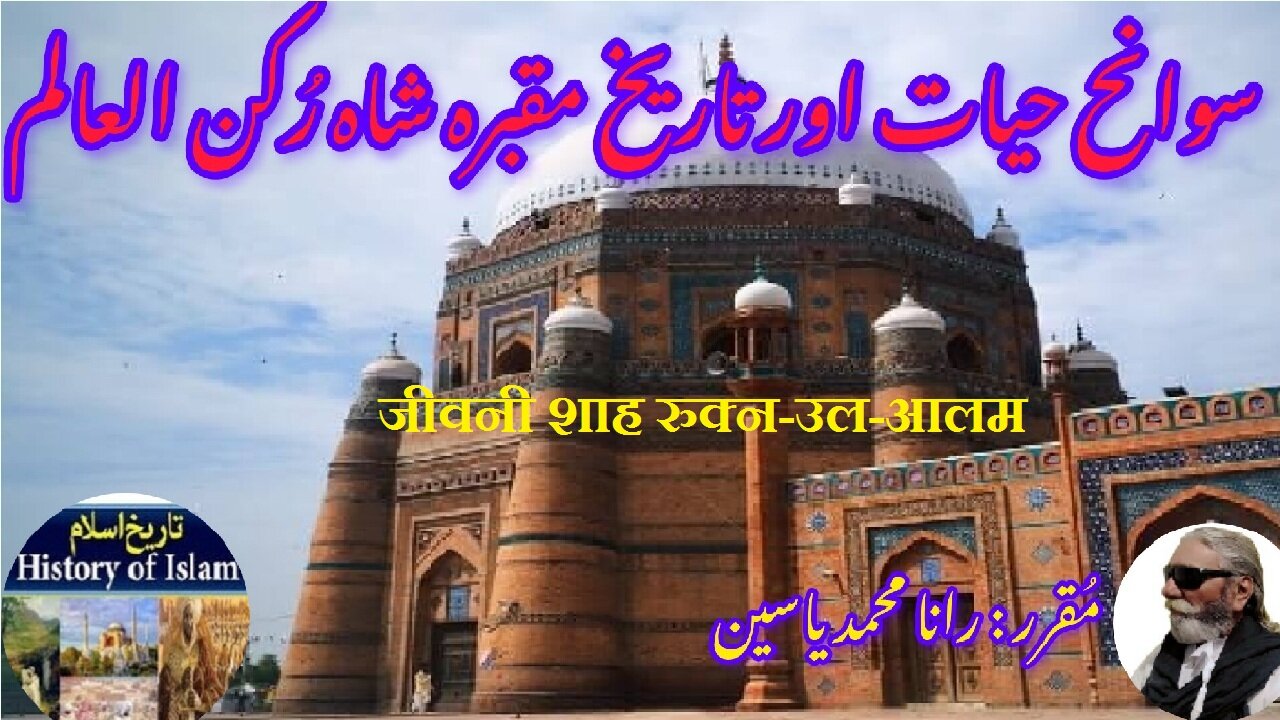Premium Only Content

Shah Rukn-ul-Alam | जीवनी शाह रुक्न-उल-आलम | شاہ رکن العالم کی سوانح عمری اور مزار کی تاریخ
@islamichistory813 #biography #shah #ruknulalam #sufisaint #cultural #heritage #biography #islamic #mysticism #islamic #philosophy #shrine #historical #figures
Biography of Shah Rukn-ul-Alam and the history of his shrine
Dekhti Aankhooon aur sountay kaanoon ko Asslamoalaikum, sisters, brothers friends and elders, in informative series videos of Islamic ascolars, sufisaints, cultural heritages, islamic philosophys, islamic mysticisms and historical figures. today we are describing biography of Shah Rukn-ul-Alam and the history of his shrine.
Sheikh Rukn-ud-Din Abul-Fath, popularly known as Shah Rukn-ul-Alam or the "Pillar of the World," was one of the most influential Sufi saints in the Punjab region during the 13th and 14th centuries. Born on November 26, 1251, in Multan, which is now part of present-day Punjab, Pakistan, he hailed from a prestigious Sufi lineage. His father, Pir Sadr-ud-Din Arif, was a well-respected Sufi scholar, and his grandfather, Sheikh Baha-ud-Din Zakaria, was a renowned mystic and the founder of the Suhrawardiyya Sufi order in Multan. Shah Rukn-ul-Alam’s deep connection to Sufism was a natural consequence of his family’s strong spiritual heritage, and he was destined to play a pivotal role in the development of Sufism in the Indian subcontinent. His life and teachings left a lasting impact on the region’s spiritual landscape, and his shrine remains one of the most revered and culturally significant sites in Punjab.
Shah Rukn-ul-Alam’s early years were shaped by his exposure to Sufism through his family. His grandfather, Sheikh Baha-ud-Din Zakaria, was an eminent scholar and mystic, known for his teachings on Islamic spirituality. Under the guidance of his family members, particularly his grandfather, Shah Rukn-ul-Alam became deeply immersed in the study of Islamic mysticism, theology, and jurisprudence. His early spiritual training laid the foundation for his later contributions to the spread of Sufism in South Asia. As he grew older, Shah Rukn-ul-Alam’s spiritual insight and commitment to a life of asceticism became evident. He adhered to the principles of the Sufi path, embracing self-discipline, devotion to God, and a life of simplicity, while encouraging his followers to seek divine love and closeness to God above all worldly pursuits.
After the death of his grandfather in 1266, Shah Rukn-ul-Alam succeeded him as the head of the spiritual lineage and became a prominent figure in the Multan region. During his time as the leader of the Sufi order, he emphasized the importance of purifying the heart and focusing on inner spiritual development. His teachings were centered around the concept of *ishq* (divine love) and the idea that the true essence of Islam lay in the pursuit of a deep, personal connection with God. Shah Rukn-ul-Alam also believed in the importance of serving humanity and helping those in need. His message resonated with a wide range of people, from the common folk to the intellectual elite, and he gained a large following of devoted disciples who sought to live by his spiritual and ethical teachings.
Shah Rukn-ul-Alam’s influence spread far beyond the region of Multan. He became one of the most celebrated Sufi saints of his time, and his fame reached the courts of Delhi and other prominent centers of power in South Asia. The Mughal emperors, particularly Emperor Akbar, recognized his spiritual authority and respected his teachings. His ability to inspire devotion and his reputation for performing miracles further enhanced his status as a major religious figure in the region. He was also known for his interactions with other religious leaders and intellectuals of the time, fostering a spirit of interfaith dialogue and tolerance.
In 1335, after living a life dedicated to the service of God and the welfare of humanity, Shah Rukn-ul-Alam passed away. According to his own wishes, he was initially buried in the shrine of his grandfather, Sheikh Baha-ud-Din Zakaria. However, his coffin was later moved to the present-day tomb in Multan, where it remains a site of pilgrimage and veneration. His tomb, known as the Shah Rukn-ul-Alam Shrine, is one of the most important and iconic Sufi shrines in Pakistan, attracting thousands of visitors each year. The shrine is an architectural marvel, featuring a blend of Islamic, Persian, and Central Asian architectural styles. The structure of the tomb is known for its grandeur, with a large central dome, intricate tilework, and calligraphy that adorns the walls, reflecting the rich cultural heritage of the region.
The Shah Rukn-ul-Alam Shrine serves as a center of spiritual devotion and a place of reflection for those seeking guidance on the Sufi path. Devotees visit the shrine to pay their respects, seek blessings, and pray for spiritual enlightenment. The annual *Urs* (death anniversary) of Shah Rukn-ul-Alam, celebrated with great enthusiasm, is a major event that draws pilgrims from all over the subcontinent. The Urs is marked by spiritual gatherings, prayers, qawwali (Sufi music), and other religious rituals, providing a sense of community and devotion among his followers. The atmosphere at the shrine during the Urs is one of deep reverence and spiritual ecstasy, as devotees come together to honor the memory of a man who dedicated his life to the service of God and the spread of Sufi teachings.
Beyond its spiritual significance, the shrine of Shah Rukn-ul-Alam is a cultural and historical landmark. It represents the enduring influence of Sufism in the region and the synthesis of various cultural and architectural traditions in the Punjab. The tomb, with its unique design and majestic presence, stands as a testament to the legacy of Shah Rukn-ul-Alam and his profound impact on Islamic mysticism in South Asia. The shrine also symbolizes the broader role of Sufism in promoting peace, tolerance, and spirituality in a diverse and multifaceted region.
In conclusion, Shah Rukn-ul-Alam was a towering figure in the history of Sufism in South Asia, and his life and teachings continue to inspire millions. As the grandson and spiritual successor of Sheikh Baha-ud-Din Zakaria, he carried forward the Sufi tradition in Multan and beyond, advocating for the cultivation of divine love, self-purification, and service to humanity. His shrine in Multan remains a place of deep reverence, not just for his followers, but also for anyone seeking spiritual guidance and reflection. Through his life and legacy, Shah Rukn-ul-Alam’s influence continues to resonate across generations, making his shrine one of the most significant and cherished spiritual landmarks in Pakistan.
With this, we seek your permission until tomorrow, tomorrow we will describe the biography of Jalal al-Din Muhammad Rumi and the history of his Shrine.
===========================
-
 6:31
6:31
ISLAMIC HISTORY
1 day agoNations that spread corruption & obstruct justice کرپشن پھیلانے اور انصاف میں رکاوٹ ڈالنے والی قومیں
3 -
 8:19
8:19
MattMorseTV
7 hours ago $2.90 earnedTrump is ACTUALLY DOING IT.
13.6K26 -
 LIVE
LIVE
ZWOGs
10 hours ago🔴LIVE IN 1440p! - Tarkov w/ Casey & crgoodw1n, Kingdom Come Deliverance, & More - Come Hang Out!
100 watching -
 LIVE
LIVE
We Like Shooting
14 hours agoWe Like Shooting 625 (Gun Podcast)
155 watching -
 1:45:02
1:45:02
Glenn Greenwald
5 hours agoIsrael Slaughters More Journalists, Hiding War Crimes; Trump's Unconstitutional Flag Burning Ban; Glenn Takes Your Questions | SYSTEM UPDATE #504
100K104 -
 1:29:31
1:29:31
Killerperk
2 hours ago $0.35 earnedRoad to BF6. Come hang out #regiment #bf6
11.2K1 -
 LIVE
LIVE
Jokeuhl Gaming and Chat
3 hours agoDARKTIDE - Warhammer 40k w/ Nubes Bloobs and AoA
37 watching -
 LIVE
LIVE
Cripiechuccles
4 hours ago😁💚💙MOTA MONDAY WITH CRIPIE💚💙 👌SMOKING, GAMING & WATCHING FLICKS!:😁
29 watching -
 36:11
36:11
Stephen Gardner
2 hours ago🔥'Burn ALL TRUMP FLAGS’ says Tim Walz + Democrat CAUGHT rigging own election!
16.2K11 -
 10:10
10:10
robbijan
1 day agoHollywood’s Hidden Messages: Predictive Programming & What’s Next
13.5K11